Last week we were invited to ride along while the tug SL Herbert escorted the cement bulker Alcem Lugait into the Port of Townsville. The SL Herbert is modern Damen ASD Tug 2810 designed for towing, mooring and fire-fighting operations. The vessel is 94.22 ft (28.67m) long with a 34.22 ft (10.43m) beam and 15.94 ft (4.86m) stern draft. It can do 13.6 knots ahead and 13.8 knots astern, and has a bollard pull of 59.2 tons ahead or 57.2 tons astern.
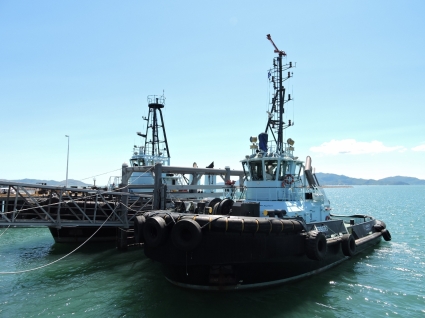
|
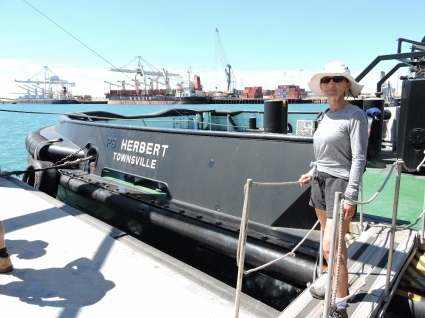
|
The Herbert is only five years old and beautifully maintained. In the first picture below, Jennifer is standing in the incredibly clean engine room next to one of the two Caterpillar 3516B TA HD/C diesel engines. The tug has a total power 4930 break horsepower (3678 brake killowats). In the second picture is our host and tug captain Mick Malone. He is a longtime friend of Nordhavn 57 Speedbird owner David Fincham, who introduced us. Next to Mick is one of the two Rolls Royce US 205 Azsimuth thrusters. The propellers they drive are a massive 7.87 ft (2400mm) in diameter.
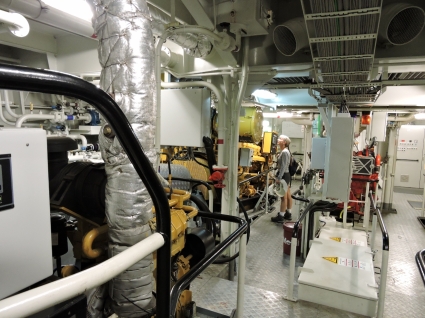
|
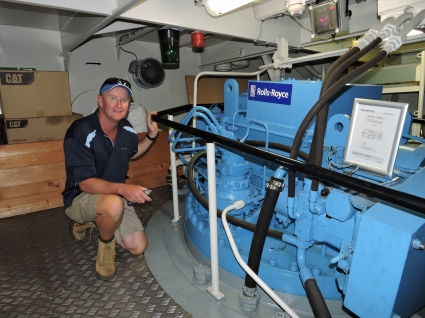
|
The tug is nearly 100 feet long but visibility from the pilot house is unimpeded through 360 degrees. All controls are designed to be within easy reach of the skipper who will either stand between the split console or pull the pilothouse chair forward and lock it into position between the helms. Each of the two nearly 8-ft props is can be rotated through 360 degrees, and from the single control the skipper can shift them into and out of gear, select any power level, and aim the prop in any direction. The vessel is as happy going backwards as forward, and has nearly the same power in each direction. The chairs in front of each half of the split console are for the two other crew members, since the Herbert runs an unmanned engine room for safety reasons. The engineer sits on the right and runs the winches, taking up or releasing the line at the skipper’s request.

|

|
Also escorting the Alcem Lugait was the tug SL Kungurri. Prior to the tugs starting to apply power to direct the Alcem Lugait into its moorage, the pilot had it very well positioned. The tugs are barely needed until the final stages of mooring where the cement bulker is brought into the final moorage location in the first picture below. Anytime 18,284 gross tons are in motion, a mistake by the pilot or either tug skipper can have highly negative consequences. This landing was made somewhat more difficult by the construction under way at the dock adjacent to this one. In the picture on the right below, you can see the Herbert nearing the construction barge as Mick directs the cargo vessel into position. At one point Mick had only a meter of room left to work as the Alcem Lugait was brought into final position.
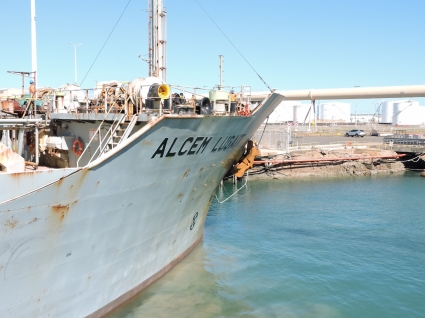
|
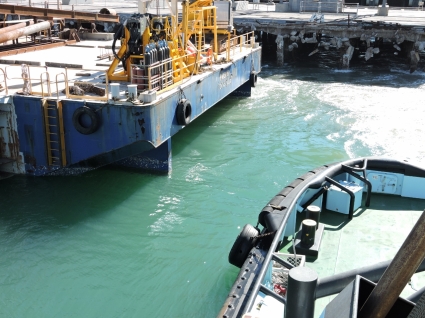
|
In the first minute of the 15-minute video below, I took the Herbert out to Platypus Channel after Mick backed us out of the berth. At the helm, the first thing that jumps out is how responsive the Herbert is. When running light, the nearly 5,000 hp and 8′ props can move the boat disarmingly quickly. It takes a bit of getting used to, but the two steerable props actually are a bit like two outboard motors where, if they are turned even a couple of degrees to the right, the boat immediately starts turning to the right. It’s quite sensitive but, if you keep the inputs small and think ahead, the boat moves predictably.
As we moved out through what had seemed like a reasonably wide channel when we came through it last on Dirona, the 95′ tug with 34′ beam felt surprising snug. This partly was because it’s a big boat, but mostly because it has so much power and is so responsive that a single sloppy input would immediately eat up the free space. Once out in the channel I tried turning the tug around several times and it was fairly easy to handle but it definitely holds your attention even when making low-stress moves. What was more difficult was trying to get the tug to move directly sideways which is an important ship assist maneuver. I never really did get sideways without fore and aft motion but from watching Mick I can see the technique is to put one prop pushing diagonally forward and sideways in the direction you want to go. The thrust from the other prop is used to counter the boat rotation and any fore and aft motion caused by the first. If you watch the video, you’ll see that Mick makes these transitions with precision and without even thinking about it. When the pilot calls for power, it happens sometimes even faster than the confirmation can be radioed back.
Listening to the video of the ship being brought in, you can hear the pilot calling for power from the tugs with commands like “1/2 ahead forward” which is a request for the Herbert to apply 2,500 hp to help push the cargo vessel towards the dock. I found it interesting how frequently the pilot was adjusting the power to levels fore and aft, and how much force was required to bring the boat up against the dock. If you listen carefully in the video you can hear a female voice from shore giving distances until the ship is in position first calling 100m, then 50m, etc. You can hear the pilot calling ship handling requests to the two tugs, each of which confirms the command by repeating it. A Herbert crew-member is giving distances between the Herbert and the construction barge behind so Mick can focus on exactly what the pilot needs while at the same time not touching the construction barge. At one point you can hear the pilot checking in with Mick on the Herbert on how much room he had between his tug and the construction barge.
It’s an amazingly precise operation and a loss of focus or a slip anywhere by any member of the team could easily run up millions of dollars of damage. They manage thousdand of horsepower with the precision of a scalpel.

If your comment doesn't show up right away, send us email and we'll dredge it out of the spam filter.